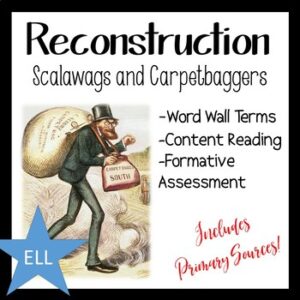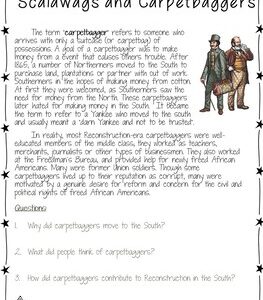Description
Engage your students with activities and content readings on the Events Leading to the Civil War – all offered as an independent work packet or for Distance Learning with Google Slides and a PDF resource with editable form fields.
In this resource, students will learn about the different Events Leading to the Civil War with content area readings, summarize their learning in a variety of process activities, and analyze maps and primary sources. Wrap up the lesson by encouraging students to write an essay from a list of 3 different topics.
You will receive:
-A Vocabulary Activity – to introduce and practice key vocabulary terms
– Preview assignments to serve as pre-reading before each content topic. These include a variety of map analysis, image analysis, or videos to watch.
– Readings for each of the topics – these are short “chunked” reading selections or key quotes to help your students understand each topic: Missouri Compromise, Nat Turner’s Rebellion, Wilmot Proviso, the Compromise of 1850, Uncle Tom’s Cabin, Kansas-Nebraska Act and Bleeding Kansas, Dred Scott Decision, John Brown’s Raid on Harper’s Ferry, the Election of Lincoln, Secession of South Carolina, and the Battle of Fort Sumter.
– Additional primary source images, quotes and video clip links. Video clips and songs are accessed with embedded links.
– Multiple Processing Activities – to keep students engaged with higher order thinking skills. These include: Beyond the Frame, Roving Reporter, Annotated Images, and more!!
⭐Please download the preview for a sample of the activity. ⭐
2019 US History TEKS for 8th Grade
(6) History. The student understands westward expansion and its effects on the political, economic, and social development of the nation. The student is expected to:
(C) explain the effects of the U.S.-Mexican War and their impact on the United States.
(7) History. The student understands how political, economic, and social factors led to the growth of sectionalism and the Civil War. The student is expected to:
(A) analyze the impact of tariff policies on sections of the United States before the Civil War;
(B) compare the effects of political, economic, and social factors on slaves and free blacks;
(C) analyze the impact of slavery on different sections of the United States; and
(D) identify the provisions and compare the effects of congressional conflicts and compromises prior to the Civil War, including the role of John Quincy Adams.
(17) Government. The student understands the dynamic nature of the powers of the national government and state governments in a federal system. The student is expected to:
(B) explain constitutional issues arising over the issue of states’ rights, including the Nullification Crisis and the Civil War.
(18) Government. The student understands the impact of landmark Supreme Court cases. The student is expected to:
(C) evaluate the impact of landmark Supreme Court decision Dred Scott v. Sandford on life in the United States.
(21) Citizenship. The student understands the importance of the expression of different points of view in a constitutional republic. The student is expected to:
(A) identify different points of view of political parties and interest groups on important historical issues;
(C) summarize historical events in which compromise resulted in a resolution such as the Missouri Compromise, the Compromise of 1850, and Kansas-Nebraska Act.
(29) Social studies skills. The student applies critical-thinking skills to organize and use information acquired through established research methodologies from a variety of valid sources, including technology. The student is expected to:
(B) analyze information by applying absolute and relative chronology through sequencing, categorizing, identifying cause-and-effect relationships, comparing, contrasting, finding the main idea, summarizing, making generalizations and predictions, and drawing inferences and conclusions;
(C) organize and interpret information from outlines, reports, databases, and visuals, including graphs, charts, timelines, and maps;
(E) support a point of view on a social studies issue or event;
(G) create a visual representation of historical information such as thematic maps, graphs, and charts representing various aspects of the United States; and
Please review all product descriptions and previews. If you have a question, contact me before you purchase at SocialStudiesSuccess1@gmail.com. As this is a digital product, all sales are final.
❤️ Dawn















Reviews
There are no reviews yet.